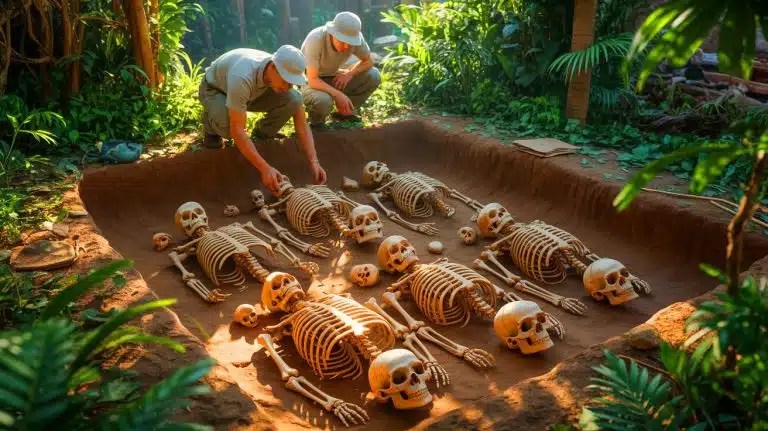| IN A NUTSHELL |
|
In a groundbreaking study published in the Proceedings of the National Academy of Sciences, evidence has emerged that challenges the long-held belief about the origins of mummification practices. Researchers have identified intentional human mummification in Asia, predating the well-known Egyptian mummies by thousands of years. The findings suggest that hunter-gatherer groups across southern China and Southeast Asia practiced a form of mummification through smoke-drying corpses. This remarkable discovery not only rewrites the history of mummification but also sheds light on the cultural practices of ancient societies in the region, indicating a complex relationship with death and the afterlife.
Study Scope and Main Findings
The research delved into numerous pre-Neolithic burials, where bodies were found in tightly crouched or squatting positions. This posture, coupled with patches of burning observed on the skeletons, provided critical clues about the mummification process. The study revealed that these bodies were not buried as fresh cadavers. Instead, they were desiccated through a prolonged, low-temperature smoke-drying process before burial. Such findings were supported by laboratory analyses, including X-ray diffraction and infrared spectroscopy, which indicated molecular changes in bones consistent with low-intensity heat exposure.
This evidence suggests that deliberate mummification practices were in place as far back as 12,000 to 14,000 years ago. This timeline starkly contrasts with the previously oldest known mummies found in northern Chile, dated at around 7,000 years old, and those from Ancient Egypt, from approximately 4,500 years ago. The implications of this research are profound, as it places the origins of mummification in Asia long before South America and Egypt, challenging traditional narratives of ancient mortuary practices.
How the Researchers Reached That Conclusion
To ascertain whether heat treatment had occurred, the research team used advanced mineralogical and spectroscopic techniques. These methods detected chemical changes in the bones that signaled sustained, low-temperature heating. This type of heating aligns with the conditions created by smoking a body over a low fire for extended periods. According to study author Hsiao-chun Hung, smoked mummification is a meticulous process that can last about three months, during which the body is continuously heated.
The study draws parallels between these ancient practices and ethnographic records of the Dani people of New Guinea, who have historically engaged in similar smoke-drying techniques as part of their mortuary traditions. If validated, these findings extend the timeline for documented artificial mummification to thousands of years before the Chinchorro mummies of South America and ancient Egyptian embalming techniques. Co-author Peter Bellwood suggests that the results reflect a longstanding regional mortuary tradition and propose connections with early populations that eventually settled in Oceania.
Implications for the Understanding of Ancient Cultures
The discovery of such an ancient mummification practice in Asia provides valuable insights into the cultural and spiritual lives of these early societies. It suggests that these communities had developed complex rituals around death and ancestor veneration. The smoke-drying process likely served both practical and spiritual purposes, preserving bodies for extended periods to maintain social and spiritual ties with ancestors.
This practice could have allowed communities to engage with their deceased over large distances and long timescales, reinforcing social cohesion and cultural identity. The findings offer a glimpse into the sophisticated mortuary practices of ancient hunter-gatherer societies, highlighting their technological ingenuity and deep spiritual beliefs. The study opens up new avenues for research into the spread and evolution of mummification practices across different regions and time periods.
Challenges and Future Research Directions
The study’s conclusions have sparked interest and debate among the scientific community. While the research provides compelling evidence for early mummification practices in Asia, it has also drawn cautious responses from some experts. Concerns have been raised about the robustness of the dating methods used and whether smoke-drying was consistently applied across all examined sites.
Further research is necessary to validate these findings and explore their broader implications. Additional dating, sampling, and comparative analyses will be crucial to map out the extent and continuity of this tradition. As researchers continue to investigate these ancient practices, they hope to uncover more about the cultural and technological innovations of early human societies. This study not only enhances our understanding of ancient mortuary practices but also invites us to reconsider the complexity and diversity of human cultural evolution.
The revelation of an ancient mummification tradition in Asia challenges previous assumptions about the origins of this practice. It underscores the intricate relationship between early human societies and their dead, revealing a rich tapestry of cultural traditions. As this research continues to unfold, what other hidden aspects of ancient cultures might we uncover, and how will they reshape our understanding of human history?
Did you like it? 4.5/5 (26)







Wow, this changes everything I thought I knew about mummies! 🤯
Wow, so Asia had mummies before Egypt? That’s mind-blowing! 😲